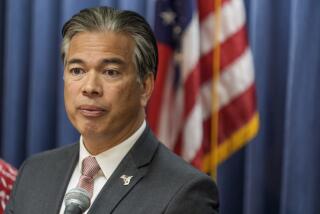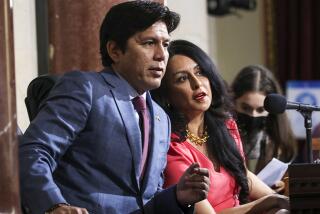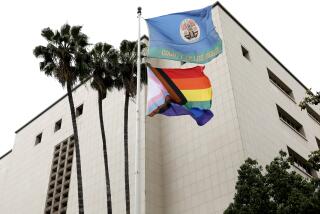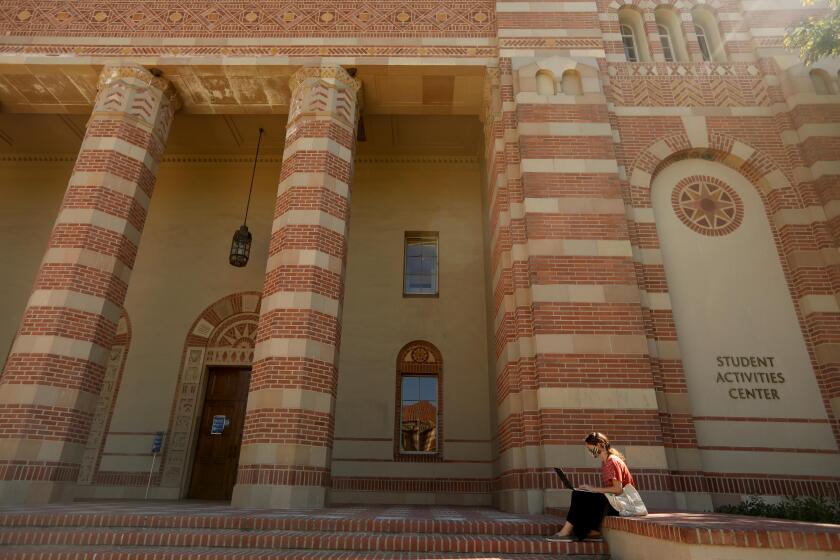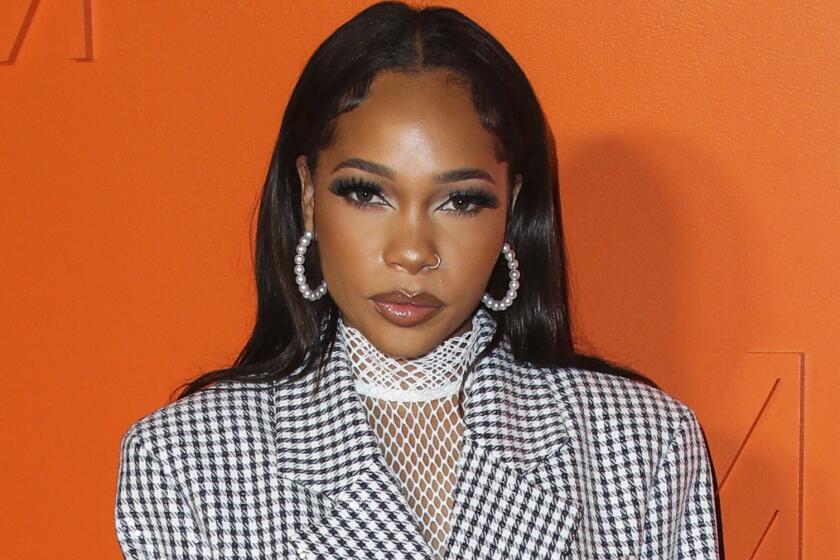SPECIAL REPORT * They’re gaining clout everywhere in the region, but a legal challenge contends that because of a flawed selection process . . .Latinos Are Underrepresented on County Grand Jury
- Share via
Even as Latinos have gained political clout in recent years, the Los Angeles County Grand Jury, which investigates everything from capital murder cases to government waste, remains a throwback to an older, whiter Los Angeles.
Latinos make up 20% of the Los Angeles City Council and county Board of Supervisors, but there isn’t a single Latino among the 23 members of this year’s grand jury.
For a dozen years, Los Angeles County’s predominant minority--now more than 40% of the population and nearly a quarter of the pool of eligible jurors--has been so underrepresented on the grand jury that a new statistical analysis concluded that the scant numbers could not have occurred by accident.
The county’s 428 judges each can nominate two grand jurors; members of the public also may volunteer for the grand jury. All the candidates are then screened by a committee of a dozen judges. And one simple fact stands out: For the 1999-2000 grand jury, the judges failed to nominate a single Latino.
The typical grand juror, the study showed, is white, male and over 60. That has been true for at least a dozen years, despite the fact that Latinos have consistently volunteered for service.
“This is a system that cries out for reform,” said Thomas Saenz, regional counsel for the Mexican American Legal Defense and Educational Fund. “The criminal justice system has to be viewed as fair, and having a grand jury excluding one racial group is unfair.”
By excluding some minorities from the grand jury, legal analysts say, the courts are excluding their points of view. As a result, they say, prosecutors gain an unfair advantage: a homogeneous grand jury that is less likely to question police testimony and more inclined to serve as a rubber stamp for indictments.
Since the 1970s, criminal defense attorneys have challenged the grand jury’s lack of ethnic diversity. For the most part, they have been unsuccessful.
But now a new challenge--perhaps the most ambitious yet--will be argued Monday in Los Angeles Superior Court by criminal defense attorneys Victor and Janet Sherman. They represent Jaime Alejandro Mares, a Latino man indicted last year on two counts of murder and an array of other charges stemming from a 1998 police chase.
The defense lawyers are seeking more than a second chance for their client. They also aim to change the way the grand jurors are selected in Los Angeles.
“A system that presumes to be fair cannot possibly have the confidence of the public if it is so discriminatory toward the largest minority in Los Angeles County,” said Victor Sherman.
Alleging abuse of the grand jury, the challenge ultimately seeks to abolish what it claims is an archaic, discriminatory system. This time, the numbers have been analyzed in a way that shows a longtime pattern of excluding minorities.
Because the client is Latino, the study focused on his ethnic group. But Latinos are not the only minority underrepresented on the grand jury, the numbers show. The problem is the same for Asians: There are none on this year’s grand jury.
By contrast, six African Americans sit on the panel. Blacks gained better representation during the furor in the early 1990s over the Rodney G. King police beating cases.
Monday’s grand jury challenge is likely to prove embarrassing for the judges on the Superior Court, because they bear responsibility for the makeup of the grand jury and its lack of diversity.
And, despite the figures, Latino groups have been uncharacteristically silent on the issue.
“We’ve got groups complaining because there aren’t sufficient minorities on television,” said criminal defense attorney Dale Rubin, who challenged the grand jury’s ethnic makeup in 1994 and lost. “If that is important for entertainment, why isn’t it important to have a well-rounded perspective on the grand jury?”
The process by which grand jurors are selected in Los Angeles dates to the 1920s, when judges appointed citizens to civil panels charged with issuing advisory reports to government agencies.
A committee of Superior Court judges each year continues to draw grand jurors from a small pool of volunteers and others nominated by jurists.
Although there is some diversity on the bench, judges inhabit an insular world as members of the legal establishment. And in Los Angeles, as elsewhere, that establishment remains largely white, male and conservative. Judges are not inclined to rock the boat, explained one female judge who spoke frankly but requested anonymity.
“Judges--who do they know? They know everybody like them,” agreed attorney Rubin.
The process of choosing grand jurors begins in late August or early September, when the call for volunteers and judicial nominees goes out through the media and mailings to judges. By November, the committee of about a dozen judges begins interviewing the scores of volunteers.
Meanwhile, judges have until late March to nominate members of the panel, and a list of all candidates is prepared in early April.
By early May, the list is finalized and the first random drawing is held for 40 jury candidates and 10 alternates. Background checks are conducted, and the successful candidates are invited back for a final drawing in June for the 23 grand jurors and four alternates.
For the 1999-2000 grand jury, 120 people volunteered and judges nominated 27 others. No breakdown was available for how many of the volunteers made it onto the panel.
“There is a serious problem with the way in which people are chosen for the grand jury in Los Angeles County,” concluded John R. Weeks, author of the statistical study that provides the backbone for the latest legal challenge. “L.A. County is what you could call a dinosaur in the state.”
In the law-and-order climate of the 1990s, a series of legislative changes expanded the grand jury’s powers to include issuing subpoenas in criminal investigations.
Prosecutors increasingly turned to the secret panels in sensitive or complicated cases when they needed to compel testimony and the production of documents, or when they sought to avoid lengthy preliminary hearings.
Los Angeles indeed lags behind other counties and the federal system, which now draw their criminal grand jurors from a larger, more ethnically diverse pool of names pulled from voter registration and Department of Motor Vehicles rolls.
Either in response to legal challenges or simply because they thought it was a good idea, several California counties have adopted a dual grand jury system.
Under that system, the civil grand jurors, still chosen from among volunteers or judicial nominees, continue to audit government agencies and look into corruption and waste during their one-year terms. The criminal grand jurors, chosen from the regular jury pool, serve terms lasting from three to six months.
Counties that have implemented the dual grand jury system include San Diego, Orange, Santa Barbara, Santa Clara, San Francisco and San Bernardino. Ventura County is considering the idea.
In New York, New Jersey, Ohio and other states where the grand jury is used primarily as a criminal investigative tool, authorities have been so concerned about diversity that they are considering adding the names of utility customers and welfare recipients to the pool.
This week’s legal challenge seeks to force the issue on the nation’s largest court system--even as a committee of judges is screening applicants for next year’s grand jury.
What makes this challenge different, attorneys and legal experts say, is the ripeness of the issue--and of the numbers.
Weeks’ statistical analysis appears to satisfy legal hurdles set by U.S. Supreme Court decisions: that Latinos are a distinctive group in the community, that they are underrepresented on the grand jury, that this is because of structural and systematic exclusion in the selection process, and that such exclusion amounts to discrimination.
As a result, the burden of proof now should shift to the prosecutors, court papers say, to prove the numbers wrong.
The case that is the subject of the challenge received widespread publicity because one of the victims was Los Angeles Police Officer Brian Brown, a single father whose young son, Dylon, wearing an LAPD baseball cap, spoke poignantly of his sorrow at a Parker Center news conference and again at his father’s memorial service.
Weeks, a San Diego State University geography professor who has studied juries and minorities since the 1970s, crunched the numbers from more than a dozen years of Los Angeles grand jury pools and panels. He found that each year, without exception, Latinos have been “significantly underrepresented.” He established that it was a longtime pattern, and that rather than getting better, things are getting worse.
“The current year represents the highest disparity between the eligible Hispanic grand juror population and those who actually enter the grand jury pool in 13 years,” Weeks said.
He found that Latinos have been so consistently underrepresented on the grand jury over the years that it couldn’t have happened by accident. He placed the chances of it occurring randomly at zero.
For example, the current grand jury, including alternates, consists of 20 whites, six blacks and one person who did not disclose ethnicity, but no Latinos or Asians. Only eight Latinos were in the pool from which the grand jurors were chosen, compared with 97 whites, 35 blacks and seven of “other” ethnic backgrounds.
Weeks calculated that, had the grand juror pool been chosen from the larger, more diverse general jury pool, 34 Latinos would have been included.
“There is no real chance that we could have gotten so few if the grand jury was a fair cross-section of the jury-eligible population,” Weeks said.
“Sometimes there are numbers that are so stark they strongly suggest intentional discrimination,” said Saenz of MALDEF.
Superior Court Judge Aurelio Munoz, who for the past seven years has headed the grand jury selection committee, acknowledged: “I can’t dispute the numbers. It’s a problem.”
He said he has sought an obvious solution, a second grand jury for criminal matters, but has been frustrated by resistance from Dist. Atty. Gil Garcetti. The criminal grand jurors would be selected on a random basis. Munoz said Garcetti, who would not comment for this story, claimed his office cannot afford it.
Sandi Gibbons, a spokeswoman for the district attorney, said adding a second grand jury to handle criminal matters was not opposed by the D.A.’s office, though some judges in the criminal courts did not favor it. She said the idea was last mentioned in 1995, when Munoz circulated a letter.
As for additional cost to the district attorney, Gibbons said there would be none, because the office already assigns one prosecutor to oversee criminal matters before the grand jury. That would not change if a separate criminal grand jury were established, she added.
The district attorney, Gibbons pointed out, does not have the power to decide whether the county seats one grand jury or two. “That’s the courts’ function,” she said.
“I don’t think it’s the D.A. who’s blocking this,” she said. “I think it’s the other judges.”
Munoz, a civil court judge, believes the cost of impaneling a second grand jury would be minimal and the benefits immeasurable. The courts would supply the room, the stenographer and the clerk. All the district attorney would have to provide is a staff lawyer. “The district attorney has opposed it,” Munoz said. “I don’t know why. We have asked, and they have refused.”
Some other judges said they too have been frustrated, but they pointed out that it takes a squeaky wheel to bring about change in a legal system structured to maintain the status quo until told by a higher court to change.
“It takes someone to show them that it’s broke before they’ll fix it,” said one judge, who spoke on the condition of anonymity.
And the courts are already burdened this year by two other reforms: the consolidation of the Superior and Municipal courts, and the switch to a one-day, one-trial jury system.
Munoz said the grand jury’s time demands (five days a week, 50 weeks a year) and puny paychecks ($25 a day) have made it hard to find qualified Latinos to nominate. Other judges involved in the selection of grand jurors say they are also trying to encourage minority groups to participate, without much luck.
But the numbers would indicate an unsuccessful effort.
Only about 20 judges offered nominations last year, and most of them nominated just one person, said Superior Court Judge Jacqueline Connor. As to the inclusion of Latinos, however, her information seemed out of date. “We have them all the time,” she said.
Criminal defense attorneys say an ethnically diverse grand jury isn’t a priority for judges or the district attorney.
Attorney Rubin said that after he challenged the grand jury, “We got nothing but problems from the bench. The judges didn’t like it. They were upset that we were bringing the motion.”
He said judges expressed their displeasure by withholding his usual court appointment fee. He turned to the appellate courts to order payment for the time and expenses he invested in the grand jury challenge.
Victor Sherman says he’s committed to reform, no matter what it takes. If he loses on Monday, as many lawyers expect, he vows to appeal.
But Judge Munoz, for one, concluded: “Sooner or later it has to be addressed; there’s no question about it.”
(BEGIN TEXT OF INFOBOX / INFOGRAPHIC)
Underrepresented on Grand Jury
Los Angeles County’s predominant minority of Latinos has been consistently underrepresented on the grand jury. The grand jury pool consists of volunteers and people nominated by Superior Court judges. The grand jury panel consists of 23 grand jurors and four alternates.
*
More to Read
Sign up for Essential California
The most important California stories and recommendations in your inbox every morning.
You may occasionally receive promotional content from the Los Angeles Times.
